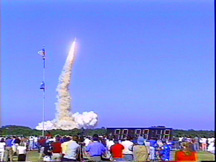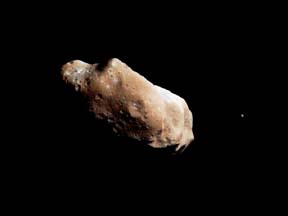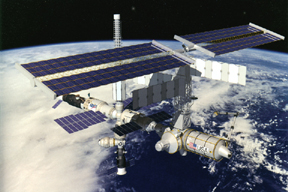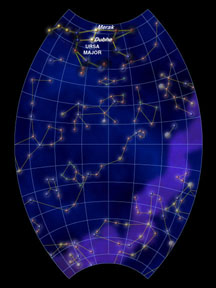Dubhe and Merak are just two of the twelve stars discovered by the Windows scientists. These two are located in Ursa Major.
Click on image for full size
Windows to the Universe original image
Windows Team Discovers Twelve Stars!
News story originally written on February 22, 2000
Something new and exciting is happening at Windows to the Universe! Windows scientists say they discovered twelve new stars, including one that is the second brightest in the night sky! They decided to create web pages for each of these stars. Windows scientists can't believe no one has discovered them before.
"It's truly amazing!" writes Chris Gleason, one of the scientists that discovered the stars. "We don't understand how others missed these bright stars in constellations like Leo, Ursa Major and Virgo. We gave each star a name and made a page with some information about them."
Highlights of the discoveries include the North Star, also known as Polaris, the famous...er... bright star Algol, and Acrux, a star in the constellation Crux, which isn't even visible from the Windows office!
"I'm just so excited about these stars! We will continue to search our books...er...sky to find more of these bright objects. Until then, we recommend that users study these stars and their constellations," Gleason said.
Stay tuned for further updates...
You might also be interested in:

What's in a Name: Arabic for "head of the demon" Claim to Fame: Represents Medusa's eye in Perseus. A special variable star that "winks" every 3 days. Type of Star: Blue-white Main Sequence Star, and
...more
It was another exciting and frustrating year for the space science program. It seemed that every step forward led to one backwards. Either way, NASA led the way to a great century of discovery. Unfortunately,
...more
The Space Shuttle Discovery lifted off from Kennedy Space Center on October 29th at 2:19 p.m. EST. The weather was great as Discovery took 8 1/2 minutes to reach orbit. This was the United States' 123rd
...more
A moon was discovered orbiting the asteroid, Eugenia. This is only the second time in history that a satellite has been seen circling an asteroid. A special mirror allowed scientists to find the moon
...more
Will Russia ever put the service module for the International Space Station in space? NASA officials want an answer from the Russian government. The necessary service module is currently waiting to be
...more
A coronal mass ejection (CME) happened on the Sun early last month. The material that was thrown out from this explosion passed the ACE spacecraft. The SWICS instrument on ACE has produced a new and very
...more
J.S. Maini of the Canadian Forest Service called forests the "heart and lungs of the world." This is because forests filter air and water pollution, absorb carbon dioxide, release oxygen, and maintain
...more















